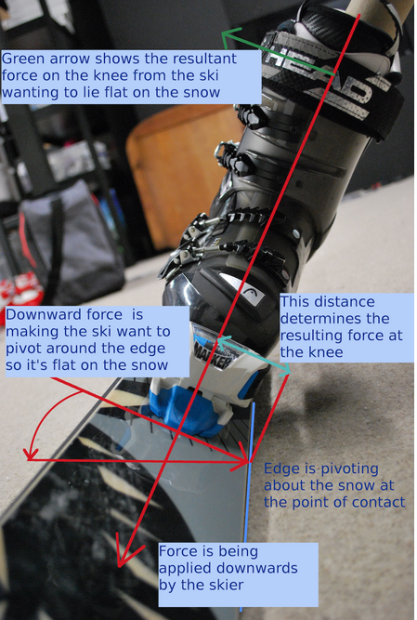
This is a question that has been around since fat skis first hit the market. There aren’t any science-proof answers yet as no long term studies have been performed. But if you’ve ever skied fat skis all day on groomers, you know that they create forces on your knees that skinny skis don’t.
Could fat skis cause knee problems in the longer term?
by PowPowPow.org
As the ski starts to get fatter than your foot, you’re not just setting the ski on edge but also levering yourself up off the snow. This has a double effect : 1 you’re adding the force required to lift you off the snow to to the forces involved and 2: the wider ski is adding a longer lever to the lateral forces applied to your knee.
I pulled together a very basic 2D model in Working Model 2D which allowed me to play with forces and angles. I used rough measurements of my own leg and body to get an idea of lengths, weights and forces. and then simplified the model such that the interface between the ‘ski edge’ was a simple pivot, the ski and lower leg element were a solid structure, and the knee joint between the lower and upper leg elements was another simple pivot.
I then set the model at 30 degrees to the horizontal and applied a force directly down through the leg, somewhat similar to carving a turn on a wide flat piste. As expected, without any lateral force supporting the knee joint, the system collapsed. That’s to be expected, however, we need knee stability even just to stand still, but it at least collapsed in the way I expected with the knee moving outwards as the ski flattened on the snow.
***
I would go so far as to suggest that we have not seen any significant incidence of knee injuries from this for a number of reasons.
-
Those who ski fat skis on the piste are still relatively few compared to the number of piste skiers.
-
Those who do would likely be younger and fitter so perhaps more able to cope with these forces in the short term.
-
Fat ‘all mountain’ skis of the dimensions I’m considering are still relatively new, and there’s probably just not enough people out there using them yet for any real picture to be painted of whether this is an issue.
-
As knee injuries are prevalent in skiing anyway, the width of the ski may be overlooked in diagnosing the cause of the injury in favour of more common causes.